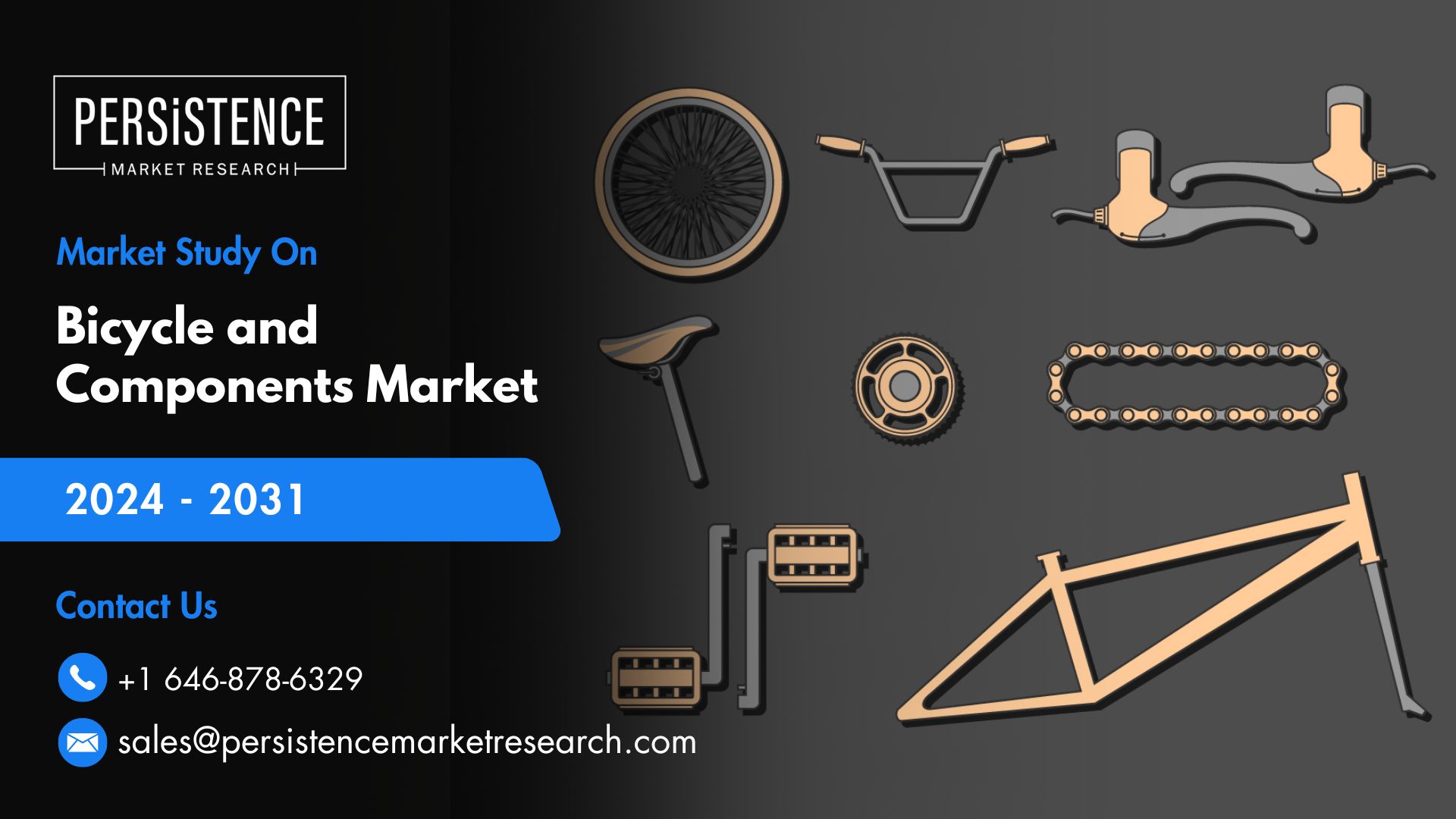The Future of Bicycle Components in the Evolving Market Landscape

Strong 8k brings an ultra-HD IPTV experience to your living room and your pocket.
The bicycle industry is undergoing a transformative shift, fueled by technological advancements, changing consumer preferences, and increased awareness about environmental sustainability. As cycling becomes an increasingly popular mode of transportation and recreation, the demand for high-quality bicycle components has surged. This trend is driving growth in the global bicycle and components market, offering a wealth of opportunities for innovation and expansion.
Market Overview
According to Persistence Market Research's projections, the bicycle and components market is estimated to reach a valuation of US$ 21 billion from the value of US$ 12.1 billion recorded in 2024. The market is estimated to secure a compound annual growth rate (CAGR) of 6.7% during the forecast period from 2024 to 2031. This substantial growth is a reflection of the rising popularity of cycling, supported by factors like urbanization, increasing health consciousness, and government initiatives to promote cycling as a sustainable mode of transport.
Bicycle components, ranging from frames and wheels to gears and brakes, play an integral role in ensuring the performance, safety, and comfort of cyclists. The ongoing innovations in materials, design, and functionality are making bicycles more efficient, durable, and accessible to a wider range of users. As the industry evolves, it is important to examine the key trends that are shaping the future of bicycle components.
Key Drivers of Market Growth
1. Sustainability and Eco-Friendly Cycling
The push for sustainability has reached the cycling industry, where bicycles are increasingly viewed as an environmentally friendly alternative to cars and other gas-powered vehicles. As cities across the globe seek to reduce traffic congestion and carbon emissions, cycling is being encouraged as a viable mode of transport. Bicycle components manufacturers are responding to this demand by investing in sustainable materials and eco-friendly manufacturing processes.
For example, there is growing interest in using recycled materials, such as aluminum and carbon fiber, in the production of bicycle frames, wheels, and other parts. Moreover, manufacturers are adopting cleaner production techniques to minimize waste and carbon footprints. This shift towards sustainable practices not only helps in reducing the environmental impact but also appeals to environmentally conscious consumers who prioritize sustainability in their purchasing decisions.
2. Technological Advancements in Bicycle Components
Technological innovation is playing a pivotal role in the development of bicycle components. From lightweight frames and energy-efficient motors to advanced gearing systems and smart cycling technologies, the future of bicycle components will be defined by cutting-edge technologies that improve performance and user experience.
Electric bicycles (e-bikes), for instance, are revolutionizing the cycling landscape with powerful electric motors that assist riders on challenging terrains and long-distance rides. The rise of e-bikes has also led to significant advancements in battery technology, such as lightweight, high-capacity lithium-ion batteries. These innovations are contributing to the overall growth of the bicycle and components market.
In addition, smart components are gaining traction in the cycling world. Devices such as GPS trackers, fitness monitors, and automated gear shifting systems are increasingly becoming integrated into bicycles. These technological upgrades are attracting tech-savvy consumers who seek advanced functionality, precision, and real-time data on their rides.
3. The Shift Towards Performance and Customization
As cycling enthusiasts become more serious about their performance, demand for specialized, high-performance bicycle components has surged. This includes lightweight frames, carbon fiber wheels, precision gears, and high-quality braking systems. The cycling community is also showing interest in custom-built bicycles that allow for personalized design and performance features tailored to specific needs.
With the increasing availability of customizable parts and accessories, riders can now select components that align with their unique preferences and riding styles. For example, competitive cyclists or enthusiasts engaging in mountain biking may opt for more durable and high-performance components, while urban commuters may prioritize comfort and efficiency over top-tier performance. The market's focus on offering a wide range of component options allows manufacturers to cater to a diverse consumer base.
4. Rising Popularity of Cycling as a Recreational Activity
Cycling has also gained popularity as a recreational activity, particularly during the COVID-19 pandemic, when many people sought outdoor activities that allowed for social distancing. As more individuals recognize the health and mental wellness benefits of cycling, there has been a surge in demand for both bicycles and bicycle components.
From city bikes and mountain bikes to road bikes and hybrid models, the bicycle market is diversifying to cater to different types of riders. As recreational cycling becomes mainstream, the demand for entry-level bicycles, as well as mid-range and high-end components, continues to grow. The availability of bicycles at various price points, along with the wide range of components that can enhance riding experiences, makes cycling accessible to more people than ever before.
5. Urbanization and Infrastructure Development
As urban areas continue to expand, the need for sustainable transportation options becomes even more pressing. Governments in major cities worldwide are investing heavily in cycling infrastructure, such as dedicated bike lanes, bike-sharing programs, and improved storage facilities. These initiatives are designed to make cycling a safer and more attractive option for urban commuters, thus encouraging greater participation in cycling.
The increased availability of cycling infrastructure is driving demand for bicycles and components, especially in metropolitan areas. Consumers are increasingly investing in bicycles equipped with high-performance components that can handle the demands of city commuting, such as durable tires, efficient brakes, and lightweight frames.
Challenges in the Bicycle Components Market
1. Supply Chain Disruptions
Like many other industries, the bicycle components market has faced disruptions in the global supply chain, particularly during the COVID-19 pandemic. Shortages in raw materials, delays in shipping, and labor shortages have led to production slowdowns and increased lead times for bicycle components. Manufacturers are working to address these issues by diversifying their supply chains and investing in local production.
2. Rising Raw Material Costs
The increasing cost of raw materials, including metals like aluminum, steel, and titanium, can impact the cost structure of bicycle components. As these materials become more expensive, component manufacturers may face pressure to raise prices, which could affect the affordability of bicycles for consumers.
3. Competition from Non-Traditional Bike Manufacturers
The bicycle and components market is also facing competition from non-traditional manufacturers, such as those in the electric mobility sector. Companies that were once focused on electric scooters and electric cars are now entering the e-bike market, bringing new technological innovations and large-scale production capabilities. This increased competition may put pressure on established bicycle component manufacturers to innovate faster and reduce costs.
The Future of Bicycle Components
Looking ahead, the future of bicycle components is set to be shaped by a combination of factors, including technological innovations, growing environmental consciousness, and a heightened focus on performance and customization. The market will continue to evolve with the development of more sustainable materials, smarter technologies, and a broader range of bicycle components tailored to meet the diverse needs of riders.
One of the key trends to watch in the future is the further integration of e-bike technologies, with components designed to optimize battery life, motor efficiency, and overall performance. Additionally, advances in 3D printing and other manufacturing processes may open up new possibilities for custom-built bicycle components, allowing riders to create personalized designs with precision.
Conclusion
The bicycle and components market is poised for significant growth in the coming years, with projections indicating a rise from US$ 12.1 billion in 2024 to US$ 21 billion by 2031, reflecting a compound annual growth rate (CAGR) of 6.7%. As cycling continues to gain popularity as a sustainable and enjoyable activity, manufacturers will need to stay ahead of market trends by embracing innovation, sustainability, and customization. By doing so, the bicycle components market will not only meet the evolving needs of consumers but also contribute to the broader push for a more eco-friendly and healthier future.
Note: IndiBlogHub features both user-submitted and editorial content. We do not verify third-party contributions. Read our Disclaimer and Privacy Policyfor details.


